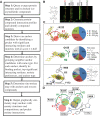SiMMap: a web server for inferring site-moiety map to recognize interaction preferences between protein pockets and compound moieties
- PMID: 20519201
- PMCID: PMC2896162
- DOI: 10.1093/nar/gkq480
SiMMap: a web server for inferring site-moiety map to recognize interaction preferences between protein pockets and compound moieties
Abstract
The protein-ligand interacting mechanism is essential to biological processes and drug discovery. The SiMMap server statistically derives site-moiety map with several anchors, which describe the relationship between the moiety preferences and physico-chemical properties of the binding site, from the interaction profiles between query target protein and its docked (or co-crystallized) compounds. Each anchor includes three basic elements: a binding pocket with conserved interacting residues, the moiety composition of query compounds and pocket-moiety interaction type (electrostatic, hydrogen bonding or van der Waals). We provide initial validation of the site-moiety map on three targets, thymidine kinase, and estrogen receptors of antagonists and agonists. Experimental results show that an anchor is often a hot spot and the site-moiety map can help to assemble potential leads by optimal steric, hydrogen bonding and electronic moieties. When a compound highly agrees with anchors of site-moiety map, this compound often activates or inhibits the target protein. We believe that the site-moiety map is useful for drug discovery and understanding biological mechanisms. The SiMMap web server is available at http://simfam.life.nctu.edu.tw/.
Figures



References
-
- Hajduk PJ, Greer J. A decade of fragment-based drug design: strategic advances and lessons learned. Nat. Rev. Drug. Discov. 2007;6:211–219. - PubMed
-
- Kitchen DB, Decornez H, Furr JR, Bajorath J. Docking and scoring in virtual screening for drug discovery: methods and applications. Nat. Rev. Drug Discov. 2004;3:935–949. - PubMed
-
- Lyne PD. Structure-based virtual screening: an overview. Drug Discov. Today. 2002;7:1047–1055. - PubMed
-
- Tanrikulu Y, Schneider G. Pseudoreceptor models in drug design: bridging ligand- and receptor-based virtual screening. Nat. Rev. Drug Discov. 2008;7:667–677. - PubMed
-
- Ewing TJ, Makino S, Skillman AG, Kuntz ID. DOCK 4.0: search strategies for automated molecular docking of flexible molecule databases. J. Comput. Aided Mol. Des. 2001;15:411–428. - PubMed
Publication types
MeSH terms
Substances
LinkOut - more resources
Full Text Sources
Other Literature Sources

